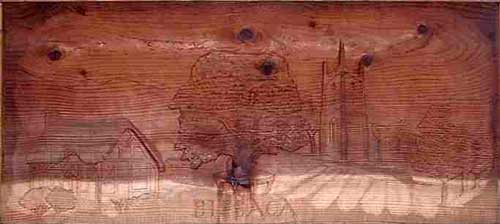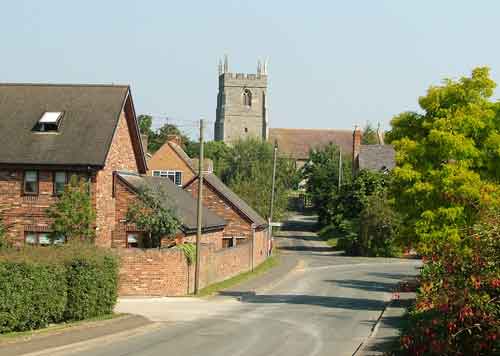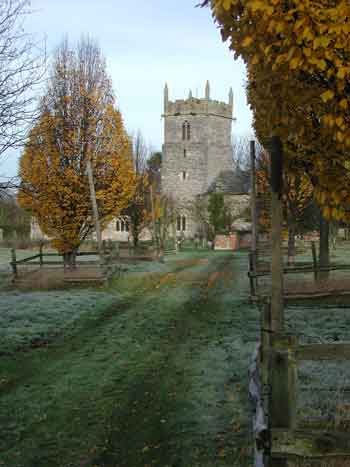
Photo 1: Bishampton Village Sign
Bishampton & Throckmorton Parishes
The ‘Hot Topics’ Questionnaire
The parishes of Bishampton and Throckmorton lie to the north east of the historic market town of Pershore. The Parish Council of Bishampton and Throckmorton represents both villages and the hamlet of Tilesford within Throckmorton parish.

Once land clearance had taken place, employment in the parishes became reliant on agriculture that was well served by country lanes connecting the neighbouring villages. However, with advances in farm machinery, few now gain their employment directly from the land though developments in technology have ensured a large economic tie to agriculture and horticulture. Presently, employment is found in the neighbouring towns of Pershore, Evesham, Worcester, Redditch as well as further afield. The current advances in information technology have encouraged some residents to become individual consultants/service providers relying upon the internet for much of their business. Thus the parishes have become significantly ‘dormitory’ and the effects on the transport infrastructure have become highly significant.

Bishampton would appear to have slumbered in the arms of history, faring more peacefully than its neighbour, Throckmorton. During the reformation and Elizabethan eras, various scions of the Throckmorton family were famously, or infamously, near the political centre stage. And since 1934 Throckmorton has been the site of significant development and upheaval, which continues to the present day!
Throckmorton is a much smaller village, originally clustered around the 13th century chapel, and the moated manor house of the Throckmorton family. The moat still exists, surrounding the now buried remains of the manor house, which is today a designated ancient monument. However, settlement in the area begins much earlier.
During the excavation of the foot and mouth burial pits, (see below) archaeologists discovered Iron Age, Bronze Age and Roman remains. These discoveries, the subject of a “Time Team” television episode, reveal that the site, which was to become Throckmorton Airfield, was once home to an Iron Age settlement built on an earlier Bronze Age one, and became later a Roman farmstead.

In February 1941 the Luftwaffe attacked the airfield three times. Between April 1941 and March 1944 the base was used for training Canadian crews and between March 1944 and 1948 No. 1 Ferry Unit, collecting and delivering all types of aircraft, used the base. From then it was used once again as a flying school, and from 1957 it was a Royal Signals Radar Establishment Flying Unit used by many different radar test-bed aircraft. It closed as an airbase in 1978, the only reminder of its history the remnants of runways, and one of the few remaining wartime control towers in the UK, which is now a listed building.
The national foot-and-mouth outbreak in 2001 brought new action to the airfield. It became a disposal site for the carcasses of slaughtered cattle and sheep. A refuse landfill site was created to the south of the airfield, in the 1960s, and will continue in use until about 2020.
The remains of Throckmorton village, along with a dozen newer houses still clusters around the chapel. The airfield cuts the village in half, separating its original centre from the few remaining houses to the west. Also to the west is the hamlet of Tilesford Park, formed of houses first built as accommodation for air force personnel, and now augmented by bungalows for the elderly and a residential rest home. Throckmorton today consists of about 80 households.The old airfield site now comprises a central area: ‘ECON 11’ in the Local District Plan. This houses high-tech electronic research, and some other small scale manufacturing. The outer area to the west and southwest is owned by DEFRA and is agricultural land.
MAP REMOVED AS LICENSE HAS EXPIRED
|
Figure 1: Bishampton & Throckmorton Parishes |
The Parish Plan is intended to operate at the most local level of the planning system, expressing the views and strategic intent of the parish, the first tier of local government. As such it sets out guidelines for the Parish Council’s decisions and initiatives and provides an action plan for the whole community.
Development of the Bishampton and Throckmorton Parish Plan began in 2002, with the coming together of the Parish Plan Steering Group consisting of Parish Councillors and residents of the parishes and open to any to attend.
The first step was the ‘Hot Topics’ Questionnaire, which asked respondents simply to list their top three (or more) issues in relation to living in Bishampton and Throckmorton. In order to maximise returns, questionnaires were delivered in person to one in four households and followed up by repeat calls until returned. This achieved a 100% response rate of 88 households. In addition all parishioners were invited to send in their ‘Hot Topics’ through the local newsletter.
Analysis of the survey results are shown in the diagram below. Nine main areas of interest/concern were identified in this way, with the future of the airfield generating most comments and being mentioned by 67% of the respondent households. (More details of the ’Hot Topics’ analysis can be found elsewhere on this web site - click here)
 |
Figure
2: Most significant issues in the ‘Hot Topics’ return |
In view of an imminent public inquiry into Wychavon District Council’s Local Plan we held some initial consultation meetings that focused specifically on the issues where the Local Plan made proposals for areas/issues emerging in the Parish Plan, namely the airfield, landfill site and roads.
Meetings were held in both Bishampton and Throckmorton. All parishioners were notified of the meetings by advertisements and circulars to every household. The results of the ‘Hot Topics’ survey regarding the airfield and the landfill site were displayed, with ‘pockets’ near each for people to add their comments. A map of the airfield, with the ECON 11 zone marked on it together with an aerial photograph were displayed, to make clear which section of the airfield was under discussion. Parish Councillors and members of the Parish Plan Steering Group were present to answer questions.
Parishioners were invited to register their agreement or disagreement with statements about the airfield, proposed new road to support ECON11, and the future of the landfill site. They were asked to indicate the level of support or opposition to the District Council’s proposals as set out in the Local Plan. (Full details of the consultations can be viewed elsewhere on this web site click here and copy of the report sent to Wychavon District Council can be viewed click here. )
Results from all the issues in the’ Hot Topics’ Questionnaire were presented at the 2004 annual parish meetings of both Bishampton and Throckmorton – Bishampton and Throckmorton hold separate annual meetings.
A questionnaire was constructed covering the nine ‘hot topics’ with questions derived from the themes contained in each topic, where possible retaining some of the original wording of peoples’ comments. This was distributed to every household in the parishes, with a stamped addressed envelope for return. A response of 61% was achieved being roughly the same for both parishes.
The results were analysed and this analysis presented at the 2005 annual parish meetings of each village. (All results have been posted elsewher on this web site click here)